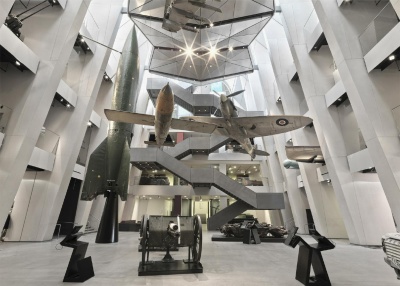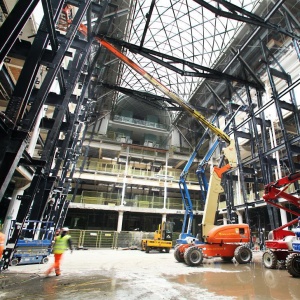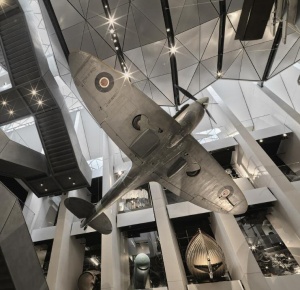First World War Galleries, Imperial War Museum, London
Structural Steel Design Awards 2015 - Award
The Imperial War Museum (IWM) was founded in 1917 and moved to the site in Lambeth on 7 July 1936. Since then it has been refurbished on numerous occasions over its history.
On 19 July 2014 – to mark the start of the Centenary of the First World War – a transformed IWM London re-opened with groundbreaking new First World War Galleries and a dramatic new atrium displaying iconic large objects and terraces featuring key stories from the museum collections.
Refurbishment of this heritage building uses structural steelwork once again to reinvigorate this British national museum. IWM London’s atrium houses rockets, planes, tanks and other military hardware as a reminder of the weapons of war developed to protect the nation in times of conflict.
The refurbishment project required the cutting-out and removal of existing concrete floors and steelwork to create an extended atrium space for the large hanging exhibits. The removal of all materials and the introduction of new materials inside the enclosed atrium area was through the constraints of the existing entrance and access ways, and often material was manhandled when mechanical means was not possible. The access way into the main atrium was complicated by having a 90 degree turn from the access way between the existing concrete columns and the atrium space. This limited the new steelwork to a maximum length of approximately 8m. Trusses, stair frames, link bridges and long columns all had to be spliced to get them in the building, which also meant substantial temporary support frames were needed to erect the individual pieces.
To add to the challenges, the project commenced before the museum underwent a temporary closure period to allow for the most invasive works to be completed.
Therefore, removal of the existing hanging exhibits from the barrel vault roof and the survey of the existing structure had to be carried out simultaneously as night-time working.
Twenty tapered Vierendeel columns connect back to the existing steel frame, holding up a high level flying steel exhibition gallery including trusses and floor beams, above which sits the magnificent retained barrel vault steel roof structure. These new intricate column structures now support the fair-faced precast concrete cladding, as well as the hung exhibits, to complete a crisp structural elevation to the atrium space. Floating steel staircase structures, infill floor structures to match and extend the existing floors, a corridor structure in the existing loading bay and two new lift structures with a triangular truss link bridge to the high level flying gallery complete this 370t of new structural steelwork on the five-storey internal structure, all of which had to match the existing floor levels.
The majority of the steelwork was finished with intumescent paint, with areas that are visible in the final condition being matched to the finish of the existing steelwork. The feature stair structure up to the link bridge was finished with a hot zinc spray sealed with a renaissance wax to the underside of the trusses and treads. The top of the treads were covered with a precast concrete nosing sat on the steel plates and the side trusses were finished with thin steel sheet wrapped tightly around the supporting steel members.
On the high level flying steel ‘Roof Terrace’, there were 12 specialist lifting lugs welded to the underside of the trusses and beams to support the aircraft hung from the flying gallery.
The erection of the high level flying steel required a load transfer operation to remove the existing columns supporting the barrel vault glazed end gable which was to be supported by the high level flying steel truss. The barrel vault glazing remained in place throughout the construction, so there could be no movement of the existing structure during the load transfer.
Due to the tight confines of the atrium area, the steel construction process had to be coordinated with numerous other trades to enable the final structure to come together.
HRH the Duke of Cambridge and the Prime Minister, David Cameron MP, officially opened the IWM London’s new First World War Galleries following the refurbishment in July 2014.
| Architect | Foster + Partners |
| Structural Engineer | BuroHappold Engineering |
| Steelwork Contractor | Bourne Steel Ltd |
| Main Contractor | Lend Lease |
| Client | The Trustees of the Imperial War Museum |
Judges' comment
A dramatic new atrium has been built within the transformed museum. Angular and robust structures frame new galleries and support war machines in a cathedral-like space. Steel construction uniquely allowed constraints of access and time to be well-answered. The visitor route is now clear and exciting.
A strong sign of success is that visitor numbers have doubled in the year.






